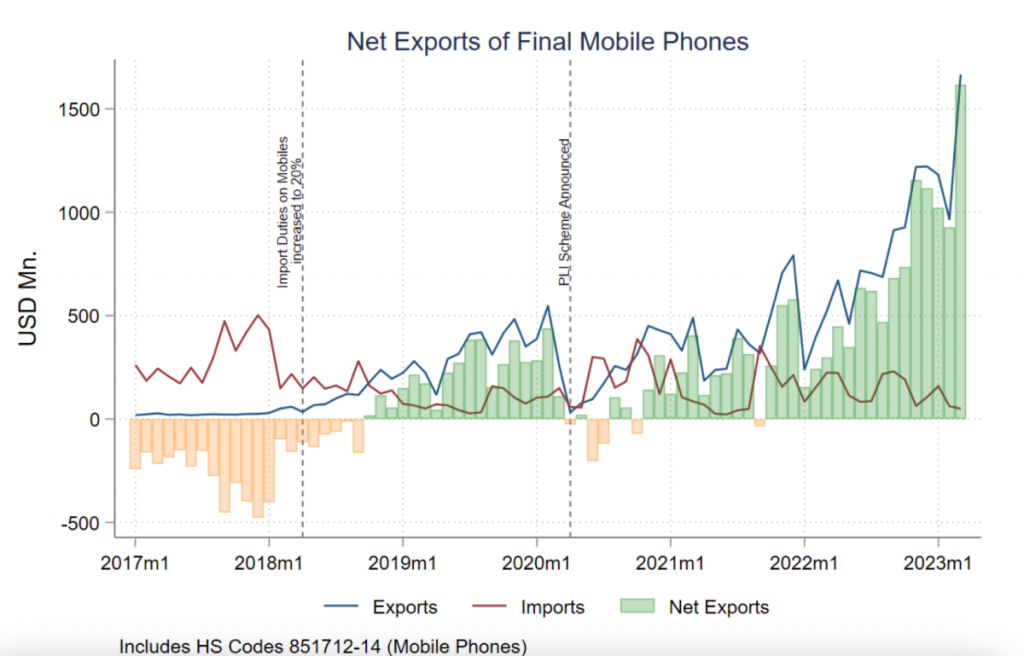Indian Economy
Production Linked Incentive Scheme
- 23 Aug 2023
- 7 min read
For Prelims: PLI Scheme for Electronic Manufacturing, Self-Sufficiency, Auto components, WTO Rules.
For Mains: PLI Scheme -Significance and Issues.
Why in News?
Recently, a debate has emerged over the effectiveness of India's Production-Linked Incentive (PLI), an Electronics Manufacturing scheme, suggesting it generates import-dependent assembly jobs rather than fostering Self-Sufficiency in manufacturing and economic growth.
What is the Production Linked Incentive Scheme (PLI)?
- About:
- The PLI scheme was conceived to scale up domestic manufacturing capability, accompanied by higher import substitution and employment generation.
- Launched in March 2020, the scheme initially targeted three industries:
- Mobile and allied Component Manufacturing
- Electrical Component Manufacturing and
- Medical Devices.
- Later, it was extended to 14 sectors.
- In the PLI scheme, Domestic and Foreign companies receive financial rewards for manufacturing in India, based on a percentage of their revenue over up to five years.
- Targeted Sectors:
- The 14 sectors are mobile manufacturing, manufacturing of medical devices, automobiles and auto components, pharmaceuticals, drugs, specialty steel, telecom & networking products, electronic products, white goods (ACs and LEDs), food products, textile products, solar PV modules, advanced chemistry cell (ACC) battery, and drones and drone components.
- Incentives Under the Scheme:
- The incentives given, are calculated on the basis of incremental sales.
- In some sectors such as advanced chemistry cell batteries, textile products and the drone industry, the incentive to be given will be calculated on the basis of sales, performance and local value addition done over the period of five years.
- The emphasis on R&D investment will also help the industry keep up with global trends and remain competitive in the international market.
- The incentives given, are calculated on the basis of incremental sales.
- Success in Smartphone Manufacturing:
- In FY 2017-18, mobile phone imports were USD 3.6 billion, while exports were a mere USD 334 million, resulting in a -USD 3.3 billion trade deficit.
- By FY 2022-23, imports reduced to USD 1.6 billion, while exports surged to nearly USD 11 billion, yielding a positive net exports of USD 9.8 billion.
What are the Issues with the PLI Scheme?
- Assembly vs. Value Addition:
- The subsidy in the scheme for Mobile and allied Component Manufacturing is paid only for finishing the phone in India, not on how much value is added by manufacturing in India, turning out that very little apart from assembly is done in India.
- So India still imports much of what goes into the mobile phones.
- WTO Constraints and Limited Value Addition:
- WTO rules prevent India from tying PLI subsidies to domestic value addition.
- Although India's aspiration to make chips is sound, chips are complex components.
- The absence of significant domestic value addition likely stems from these constraints.
- Vague Disbursal of Incentives:
- While an Empowered Committee has been formed to oversee the scheme and handle fund disbursement for different sectors, the process of awarding incentives lacks clarity.
- There are no well-defined criteria or standardized parameters that ministries and departments use to determine the allocation of these incentives, raising concerns about the fairness and effectiveness of the scheme.
- Lack of a Centralized Database:
- The lack of a centralized database that captures information like increase in production or exports, number of new jobs created etc. make the evaluation process an administrative complexities.
- This information ambiguity impacts transparency and can lead to malfeasance, further widening the fault lines and weakening the policy structure.
Way Forward
- The government must assess PLI's effectiveness, considering job creation, cost per job, and reasons for limited success.
- Extending the scheme to new sectors requires understanding its limitations and addressing underlying issues.
UPSC Civil Services Examination, Previous Year Questions (PYQs)
Q. Consider, the following statements : (2023)
Statement-I : India accounts for 3.2% of global export of goods.
Statement-II : Many local companies and some foreign companies operating in India have taken advantage of India's ‘Production-linked Incentive’ scheme.
Which one of the following is correct in respect of the above statements?
(a) Both Statement-I and Statement-II are correct and Statement-II is the correct explanation for Statement-I
(b) Both Statement-I and Statement-II are correct and Statement-II is not the correct explanation for Statement-I
(c) Statement-I is correct but Statement-II is incorrect
(d) Statement-I is incorrect but Statement-II is correct
Ans: (d)
Exp:
- According to the recent WTO’S Global Trade Outlook and Statistics report, India accounts for 1.8 % of global exports of goods. Hence, statement 1 is not correct.
- The ‘Production Linked Initiative’ (PLI) scheme offers companies incentives on incremental sales from products manufactured in India. It aims to attract foreign companies to set up units in India while encouraging local companies to expand their manufacturing units, generate more employment, and reduce the country's reliance on imports. Hence, Statement 2 is correct.







